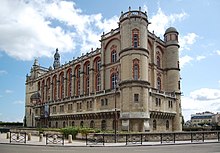Musée de Saint-Germain-en-Laye

West façade of the castle as seen from the Charles de Gaulle square
|
|
| Established | 1862 |
|---|---|
| Location | Place Charles de Gaulle 78100 Saint-Germain-en-Laye, France |
| Coordinates | 48°53′52″N 2°05′46″E / 48.89778°N 2.09611°E |
| Collection size |
Paleolithic Neolithic et Bronze age Iron age Roman Gaul Early Middle Ages Comparative archaeology of the five continents |
| Visitors | 113 023 (in 2014) |
| Website | Official website |
The musée d'Archéologie nationale is a major French archeology museum, covering pre-historic times to the Merovingian period. It is located in the Château de Saint-Germain-en-Laye in the département of Yvelines, about 19 km west of Paris.
The château had been one of the most important French royal residences in the Paris region since the 12th century. Following the move of the court to Versailles, the castle housed the court of James II of England in exile, became a cavalry school in 1809 and finally a military prison from 1836 to 1855. The château, which was in very poor condition, was classified as a monument historique on 8 April 1863.
The interior was a maze of cells, corridors, false floors and partitions. The exterior was dilapidated and covered in a black coating. The architect Eugène Millet, a pupil of Eugène Viollet-le-Duc, was given the job of restoring the château to hold the planned National Museum of Antiquities in 1855 and was told to remove all traces of the cells that the Ministry of War had installed when it was used as a prison. In 1857 he reported that all the partitions forming the cells and dungeons had been demolished and the rest of the chateau had been cleaned. Construction work began in 1862 with the destruction of the West pavilion. Millet's goal was to restore the building to its state as it was under Francis I of France. Eugène Millet died in Cannes on 24 February 1879. The restoration was continued by Auguste Lafollye and Honoré Daumet, and finally completed in 1907.
The museum was named:
The Second French Empire coincides with a great expansion of archaeology in France. Napoleon III is passionate of history and archeology, and orders digs, most notably in Alesia and Gergovia, to complete his biography of [Julius Caesar]. The question of conservation and storage of the finds quickly arises. The imperial decree creating the Musée Gallo-Romain (the Gallo-Roman museum) was signed by Napoleon III on 8 March 1862. [1]
...
Wikipedia

